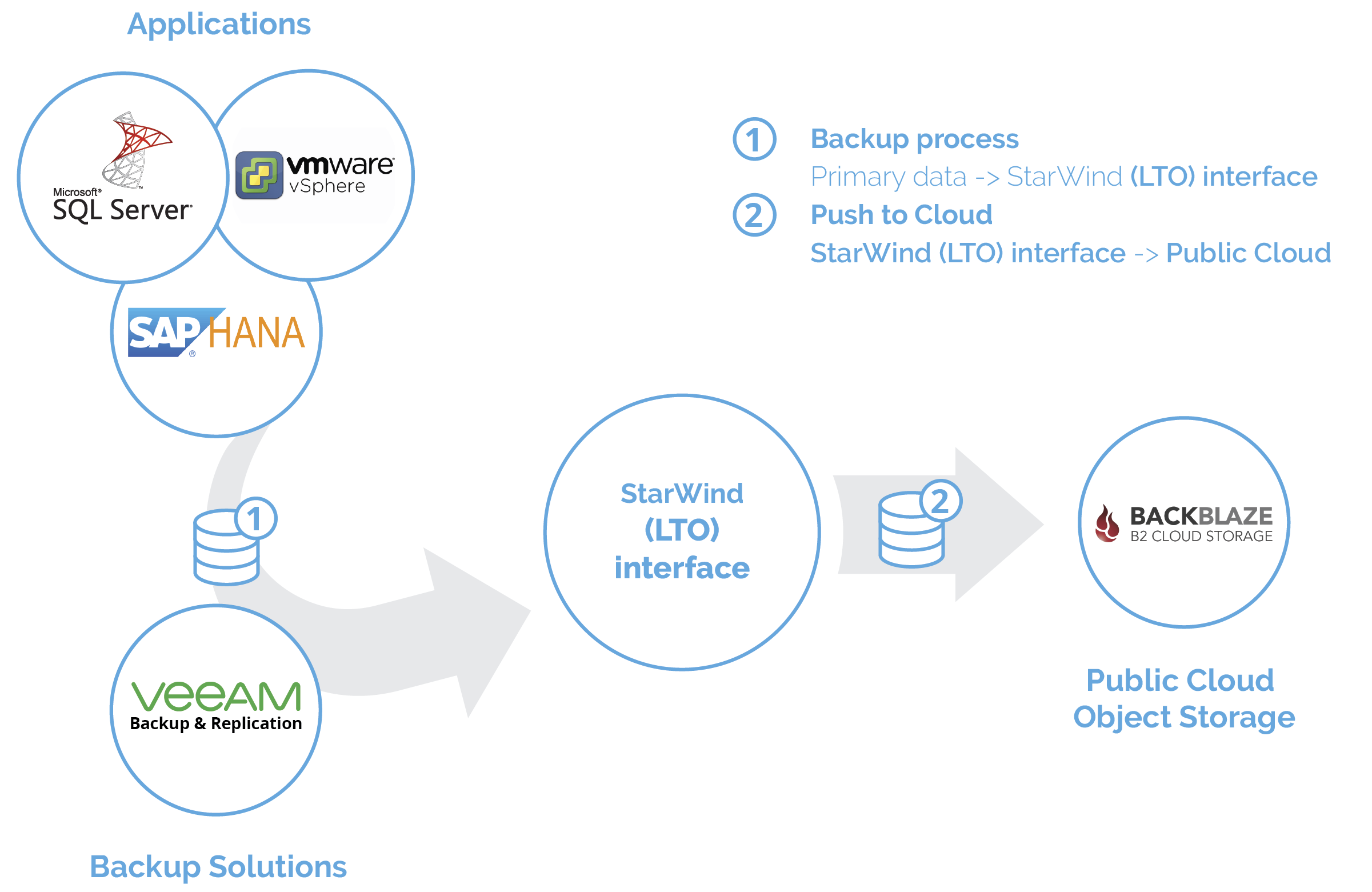Introduction
Today, we can observe that more and more businesses consider cloud as a reasonable alternative to LTO. The cloud as a backup storage helps to locate or retrieve valuable data. An increasing number of organizations already take advantage of the cloud for their backup and archival processes. Some migrate to the cloud completely and even restore in the cloud directly.
There are certain standard requirements for the cloud storage – it must be cost-efficient and reliable enough to store important company’s data or support backup and data recovery initiatives. With a traditional cloud backup storage cold backup data isn’t immediately available. Usually it takes some time to access data in the cloud that feels like a considerable delay in terms of data retrieval.
This article describes StarWind Storage Gateway for Backblaze as a solution to make local backup applications operate seamlessly with a cloud object storage. This all-in-one solution combines the ability of a backup storage pool to offload the backup data to Backblaze B2 cloud storage, and immediately retrieve it – all at a bargain price.
StarWind Storage Gateway for Backblaze is perfect for backup automation in the cloud
What is StarWind Storage Gateway for Backblaze and why use it? As organizations tend to take care of their backup environments to prevent any data loss, StarWind designed a solution that automates backup replication to a secure offsite location. StarWind Storage Gateway for Backblaze natively supports a variety of industry-standard backup solutions. The Gateway uses LTO tape interface for integration into existing infrastructures with zero change in existing data access and protection policies. It automates offsite backup replication, and allows accessing your data anytime via a user-friendly management interface.
With that being said, it would be appropriate to briefly describe the LTO interface. The technology is called Virtual Tape Library or VTL. StarWind fully emulates an industry standard physical Tape Library and stores the virtual tape images on the underlying storage, be it local, object, or cloud. The library connects to the client systems via commodity Ethernet using iSCSI protocol. Combined with automatic replication to Backblaze B2 this brings multiple benefits:
- Support for cost efficient Backblaze B2 storage added to any enterprise backup application in a non-disruptive way.
- No manual labor required for shipping tapes offsite. Offsite replication is fully automatic.
- Recover what you need and when you need it. Virtual Tape jobs can be sized down to individual VM or application backup. The format is perpetual, you can restore it easily even in 50 years.
- Backup speed. Virtual Tape is as fast as underlying storage. You minimize the performance impact on the production environment by minimizing the backup time.
- Scalability. With Cloud storage and virtualized tapes, you only pay for what you’re using.
VTL creates a universal translation layer between the backup software and cloud storage, allowing users to securely send important data to an offsite location for backup.
Once Storage Gateway is connected, the client OS recognizes the gateway as an industry-standard LTO Tape Library. Virtual Tape is replicated and stored as an image file to Backblaze B2 storage. This way, any backup, media asset management, or workflow application can work with cloud storage, solving the lack of cloud storage support problem.
Overall, this solution designed by StarWind is ideal for organizations looking to automate their data backup and archival, make their data instantly accessible, and less expensive to store in the cloud. It also enhances the flexibility of any existing backup infrastructure.
OK, sounds interesting. What about backup app in this scheme?
What do we expect from the backup? First of all, we expect a quick and accurate restore procedure.
As we all probably know by now, the recovery time objective (RTO) is the targeted duration of time and a service level within which a business process must be restored after a disaster (or disruption) in order to avoid unacceptable consequences associated with a break in business continuity. For the purposes of this article and an outstanding example, we take Veeam Backup & Replication as the leading backup solution on the market. Veeam B&R is a flexible and powerful platform for managing backups, recovery, and replication of virtualized applications and data. So, we have another brick in our backup solution. Let’s move on.
What is Backblaze and why Backblaze?
Presently, the market of cloud solutions looks a bit overcrowded. Still, what are the advantages of Backblaze B2 Cloud Storage solution, compared to competitors? That is a good question. First, B2 is extremely cheap. The price is approximately the same as cold storage offerings from competitors, but with B2 you get the convenience of hot cloud storage, allowing you to access your data immediately when you need it. Second – it is reliable. Backblaze B2 allows you to safely store your backups and be ready to quickly restore when required. As a result, we add a reliable and affordable cloud storage to our solution where we already have StarWind and Veeam B&R.
Configuration: A quick walkthrough
Now that we know the capabilities and features of each separate component of the system, let’s move to the configuration process. The scheme of the complete solution looks like in the picture below:

Veeam B&R (or any other backup solution) makes backups of your existing infrastructure and stores them on StarWind Virtual Tapes. Depending on the retention policy that you choose, you can transfer backups from StarWind to Backblaze B2 Cloud Storage to keep as an archive. The data placed in the cloud will be available for you right when you need it.
To work with LTO interface, you will need to install the StarWind Storage Gateway for Backblaze product. After you install and launch StarWind Management Console available in this solution, the program will ask you to specify the default storage pool location. To start the process, create a VTL Device.

Once the VTL device is created, add the number of tapes needed and specify the tape parameters. The created tape appears in the first slot of the VTL device in the StarWind Management Console.

Now, we can proceed to the next part of the configuration process, namely, to the cloud storage side. By this time, we expect you to have a Backblaze B2 Cloud Storage account. The registration is quick and simple, moreover, you get 10GB for free.
We need the Account ID and Application Key. You can find them by navigating to Buckets and clicking on the Show Account ID and Application Key link.

Then, just create a bucket and set custom lifecycle rules, which you can do in the Lifecycle Settings in your Backblaze account.
To enable the replication between StarWind and Backblaze B2 Cloud Storage, open StarWind Management Console, navigate to the VTL device and click Cloud Replication, then choose Backblaze B2 Cloud Storage among the list of available cloud storage providers. In the Replication Settings, specify Account ID, Application Key, Bucket Name obtained and configured previously, and press the Next button. You can also set your custom Tape File Retention Settings, like keeping tape with backups for a week, before moving or copying it to the cloud. Very easy and convenient!

All we have to do now is just discover our virtual tape device over iSCSI and install tape library drivers. Once the drivers are installed, the Medium Changer devices is shown as Hewlett Packard MSL G3 Series library (x64 based).

Now, the tape library is ready to be added to Veeam B&R. You can do it in a few clicks by choosing “Add Tape Server” option from the Tape Infrastructure tab in Veeam Backup and Replication Console.
After completing the wizard, you will see the StarWind tape library device in the Tape Infrastructure menu.

Now, that the initial configuration of StarWind Storage Gateway for Backblaze and Veeam B&R is finished, you can proceed and create new Tape Backup job with automated off-load to cloud. Select either “File to Tape” or “Backup to Tape” job and specify the files you want to back up to the virtual tape.
Choose the media pool where the data will be stored and configure the incremental backup schedule, if necessary. Specify the additional settings and check the Export current media set upon job completion to allow the automatic tape offload to B2 Cloud Storage after backup job is finished.

After the backup job is completed successfully, the tape will be ejected, exported and marked as offline. The replication process to B2 Cloud Storage will be initiated automatically, according to the StarWind Storage Gateway for Backblaze Retention Policy.
Conclusion
In this article, I’ve given a quick walkthrough for the process of backing up your data into the cloud with the StarWind Storage Gateway for Backblaze solution. The configuration process for all components was quick and simple and as a result, we deployed the backup storage able to automatically offload virtual data storage objects to a cost-efficient cloud tier.
Now, you can bring your backup infrastructure to the next level. What you get are quick restores, robust data protection experience, unmatched cost efficiency and instant data availability, as well as automated and easily accessible backups. The approach provided with StarWind Storage Gateway for Backblaze allows you to be sure of safety of your important data.
The complete and detailed configuration guide can be found here.




